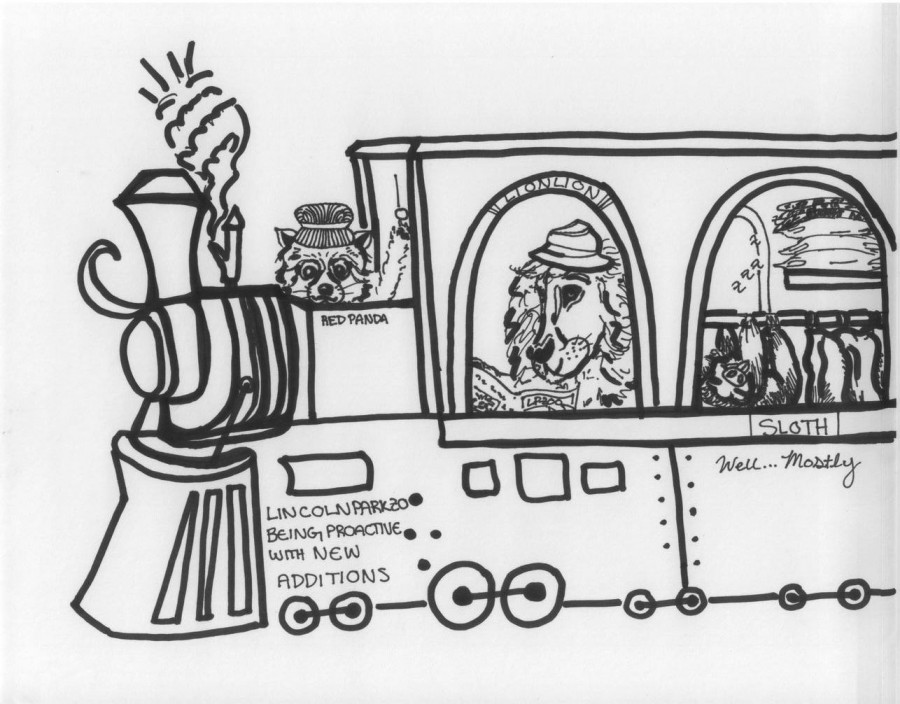New Animals at Lincoln Park Zoo
This Summer the Zoo Welcomed Two Red Panda Cubs, Two Lions, and a Sloth
The Lincoln Park Zoo is celebrating the arrival of five new animals in 2015. Two red panda cubs, Clark and Addison, and a sloth (still-unnamed), were born at the zoo. And two lionesses, Zalika and Kamali, came to the zoo at the recommendation of the American Species Survival Plan (SSP), an organization of North American zoos and aquariums set up to protect endangered species..
The Regenstein Small Mammal and Reptile House is home to the sloth. The lionesses live inside the Kovler Lion House — as do Clark and Addison, the red panda cubs (in a cage far away from the lion’s, of course).
On June 26, in a dark leaf den, Leafa, a red panda who arrived in February (also because of the SSP), gave birth to two cubs. This was the first red panda birth at Lincoln Park Zoo. The two cubs were named Clark and Addison by Sharon Zackfia, a donor who wished to reflect her Chicago pride in their names.
Red pandas are severely endangered due to habitat loss and poaching in the Himalayan Mountain Range in which they live. The SSP selected the Lincoln Park Zoo to take them in because, although the zoo never had red pandas before Leafa and her mate, Phoenix, they remained active in the organization, according to the zoo’s website.
Red pandas are animals with ambiguous lineage. Although they may look a bit like a raccoon or a bear, they are not related to either animal. Red pandas are not even closely linked to giant pandas.
Through the end of September, the panda cubs will stay with their mother. After that they will lead lives of solitude until they are moved to other zoos to mate. Although the red panda cubs will not be out until September, visitors can still see their parents behind the lion house.
The zoo’s two new lionesses are the first lionesses since the zoo’s previous lionesses died. The zoo desperately wanted a female to mate with the sole remaining lion, Sahar, especially after last year, when Sahar’s friend, Myra, the zoo’s 18-year-old female lion, had to be euthanized due to old age.
A call went out to the Association of Zoos and Aquariums (which runs the SSP). The Oregon Zoo reached out, saying they had two young sisters that needed a place to stay.
The zoo has the challenge of acclimating the new lions. The lion enclosure has been roped off to give the lions privacy as they are socialized.
“Lions are very social animals,” said Maggie, a member of the Guest Engagement Team, who requested her last name remain anonymous, “but the socializing process has to be done very slowly because they have wild instincts. They could get aggressive.”
The zookeepers put the sisters, Zalika and Kamali, in a cage next to Sahar’s with a mesh wall between them.
“They’ve been in what we call a ‘Howdy situation,’” David Bernier, the general curator at the zoo, said, “where they can see him, and smell him, and hear him, but not be in physical contact with him.”
Three weeks later, they put them in the enclosure together, with plenty of distractions ready if anything went wrong.
The keepers are struggling with socializing the lions. Sahar chases the sisters down into the moat and roars when they try to come near his territory.
Lead carnivore zookeeper Anthony Nielsen said, “It typically takes about six months until the zoo can comfortably leave the lions together overnight.’
When all three lions are out in the enclosure, a rope is set up about five feet away from the fence to give additional space between the spectators and the lions. The rope comes down when the sisters go back inside and Sahar is in the enclosure alone.
For visitors who are interested in viewing an animal up close, stop by to see the newborn sloth. Visitors can see the sloth from no further than 10 feet away, as opposed to lions which can only be viewed from over 50 feet away. Born a little over a month ago, on July 25, the baby sloth was a surprise to the zoo.
“We knew that the mother was looking a little round in the abdomen but we weren’t positive,” Dan Boehm, zoological manager at Lincoln Park Zoo, said. “So it was a bit of a surprise to us.”
The baby constantly clings to its mother, Hershey. It has never seen its father, Carlos, who has fathered twelve other babies at other zoos.
“The sloth infant appears healthy and is passing critical milestones such as nursing regularly and clinging well to mother,” Curator Diane Mulkerin said. “Hershey is a first-time mother and is being very attentive to her new young.”
Hershey is so attached to her first child that zookeepers have not been able to check the gender of the baby, and therefore cannot give it a name. Hershey hangs upside-down gripping the bark with her two toes to make a basket for the baby to sleep in. The baby, about the size of a teddy bear, will ride on its mother’s back until it is nine months old.
Of course, it — and the other new animals — are just a few of the 1,000+ animals from more than 200 species at the Lincoln Park Zoo. People at Parker tend to forget it, but they learn, play, and work next to one of the most diverse free zoos in the world.








